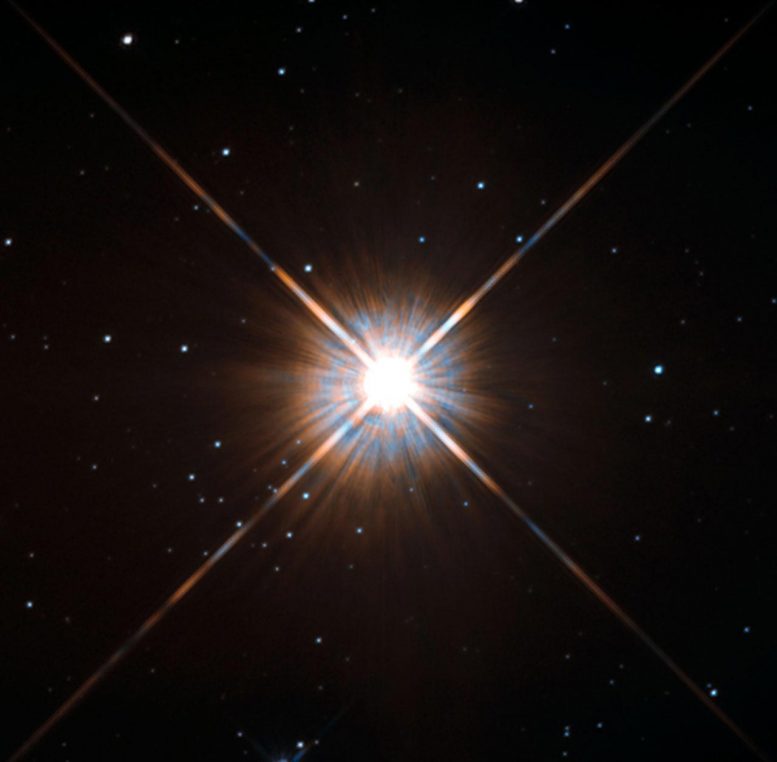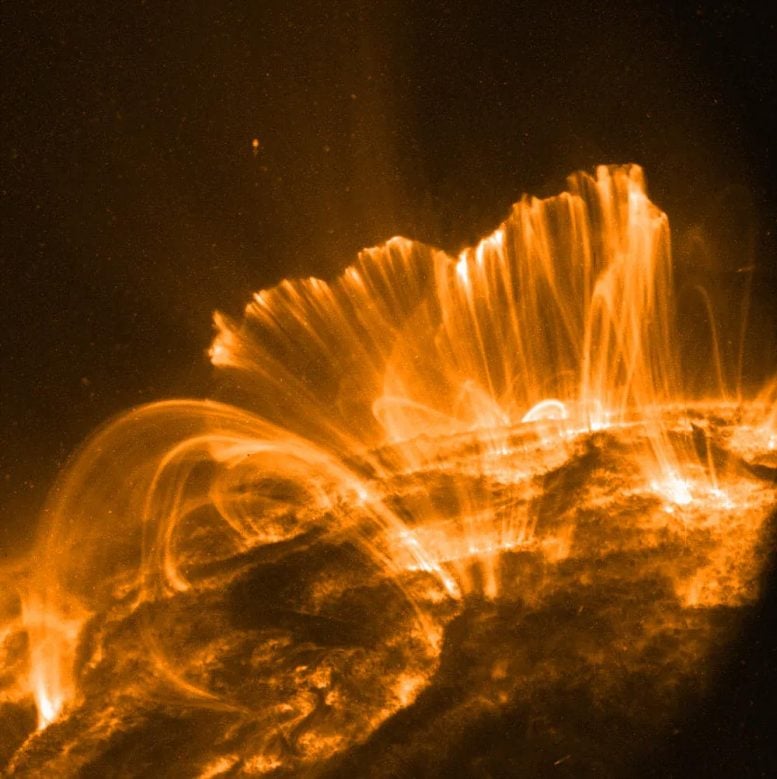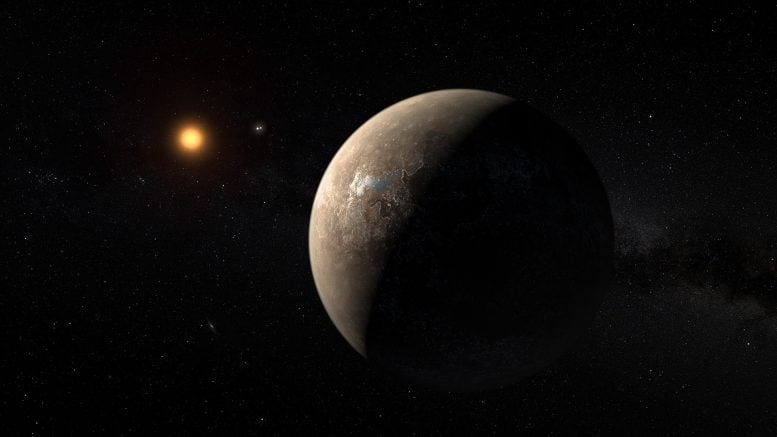
Proxima Centauri is the closest star to the solar system and is home to a potentially habitable planet. Credit: Hubble, European Space Agency
The Sun isn’t the only star to produce stellar flares. On April 21, 2021, a team of astronomers published new research describing the brightest flare ever measured from Proxima Centauri in ultraviolet light. To learn about this extraordinary event – and what it might mean for any life on the planets orbiting Earth’s closest neighboring star – The Conversation spoke with Parke Loyd, an astrophysicist at Arizona State University and co-author of the paper. Excerpts from our conversation are below and have been edited for length and clarity.
Why were you looking at Proxima Centauri?
Proxima Centauri is the closest star to this solar system. A couple of years ago, a team discovered that there is a planet – called Proxima b – orbiting the star. It’s just a little bit bigger than Earth, it’s probably rocky and it is in what is called the habitable zone, or the Goldilocks zone. This means that Proxima b is about the right distance from the star so that it could have liquid water on its surface.
But this star system differs from the Sun in a pretty key way. Proxima Centauri is a small star called a red dwarf – it’s around 15% of the radius of our Sun, and it’s substantially cooler. So Proxima b, in order for it to be in that Goldilocks zone, actually is a lot closer to Proxima Centauri than Earth is to the Sun.
You might think that a smaller star would be a tamer star, but that’s actually not the case at all – red dwarfs produce stellar flares a lot more frequently than the Sun does. So Proxima b, the closest planet in another solar system with a chance for having life, is subject to space weather that is a lot more violent than the space weather in Earth’s solar system.

Solar flares – like this one captured by a NASA satellite orbiting the Sun – eject huge amounts of radiation. Credit: NASA
What did you find?
In 2018, my colleague Meredith MacGregor discovered flashes of light coming from Proxima Centauri that looked very different from solar flares. She was using a telescope that detects light at millimeter wavelengths to monitor Proxima Centauri and saw a big of flash of light in this wavelength. Astronomers had never seen a stellar flare in millimeter wavelengths of light.
My colleagues and I wanted to learn more about these unusual brightenings in the millimeter light coming from the star and see whether they were actually flares or some other phenomenon. We used nine telescopes on Earth, as well as a satellite observatory, to get the longest set of observations – about two days’ worth – of Proxima Centauri with the most wavelength coverage that had ever been obtained.
Immediately we discovered a really strong flare. The ultraviolet light of the star increased by over 10,000 times in just a fraction of a second. If humans could see ultraviolet light, it would be like being blinded by the flash of a camera. Proxima Centauri got bright really fast. This increase lasted for only a couple of seconds, and then there was a gradual decline.
This discovery confirmed that indeed, these weird millimeter emissions are flares.

Proxima b – shown here in an artist’s rendering – is rocky and might support water or even life if the atmosphere is still intact. Credit: European Southern Observatory, M. Kornmesser
What does that mean for chances of life on the planet?
Astronomers are actively exploring this question at the moment because it can kind of go in either direction. When you hear ultraviolet radiation, you’re probably thinking about the fact that people wear sunscreen to try to protect ourselves from ultraviolet radiation here on Earth. Ultraviolet radiation can damage proteins and DNA in human cells, and this results in sunburns and can cause cancer. That would potentially be true for life on another planet as well.
On the flip side, messing with the chemistry of biological molecules can have its advantages – it could help spark life on another planet. Even though it might be a more challenging environment for life to sustain itself, it might be a better environment for life to be generated to begin with.
But the thing that astronomers and astrobiologists are most concerned about is that every time one of these huge flares occurs, it basically erodes away a bit of the atmosphere of any planets orbiting that star – including this potentially Earth-like planet. And if you don’t have an atmosphere left on your planet, then you definitely have a pretty hostile environment to life – there would be huge amounts of radiation, massive temperature fluctuations and little or no air to breathe. It’s not that life would be impossible, but having the surface of a planet basically directly exposed to space would be an environment totally different than anything on Earth.
Is there any atmosphere left on Proxima b?
That’s anybody’s guess at the moment. The fact that these flares are happening doesn’t bode well for that atmosphere being intact – especially if they’re associated with explosions of plasma like what happens on the Sun. But that’s why we’re doing this work. We hope the folks who build models of planetary atmospheres can take what our team has learned about these flares and try to figure out the odds for an atmosphere being sustained on this planet.
Written by R. O. Parke Loyd, Post-Doctoral Researcher in Astrophysics, Arizona State University.
Adapted from an article originally published on The Conversation.![]()









This is crackpot only. Próxima Centauri yeah right!
? Proxima Centauri is well known – it is our closest star.
“Proxima Centauri is a small, low-mass star located 4.2465 light-years (1.3020 pc) away from the Sun in the southern constellation of Centaurus. Its Latin name means the “nearest [star] of Centaurus”. This object was discovered in 1915 by Robert Innes and is the nearest-known star to the Sun. With a quiescent apparent magnitude 11.13, it is too faint to be seen with the unaided eye. Proxima Centauri is a member of the Alpha Centauri star system, being identified as component Alpha Centauri C, and is 2.18° to the southwest of the Alpha Centauri AB pair. It is currently 12,950 AU (0.2 ly) from AB, which it orbits with a period of about 550,000 years.”
[ https://en.wikipedia.org/wiki/Proxima_Centauri ]
Could outgassing from the planet’s crust replace the atmosphere faster than stellar flares erode it?
Seems like it, such planets have putatively been found.
“Scientists using NASA’s Hubble Space Telescope have found evidence that a planet orbiting a distant star may have lost its atmosphere but gained a second one through volcanic activity.”
[ http://spaceref.com/distant-planet-may-be-on-its-second-atmosphere-nasas-hubble-finds.html ]
It is the “flip side” that creates the possibility of life. But the first side will always be the problem. Solar UV radiation doesn’t fit very well with the prebiotic evolution of RNA/DNA.
I’m not sure what you mean. The first phylogeny that show the lineage splits rooted in geology (such as it is – early, coarse method) found life evolving from a common geological locale of deep sea alkaline hydrothermal vents [ https://www.nature.com/articles/nmicrobiol2016116 ].
So no UV problem. (Well, maybe on Mars, the alkaline silica producing hydrothermal vent Spirit got stuck in may not have been underwater. But Enceladus such vents are located beneath both ice cover and deeper water than early Earth’s – likely – global ocean.)
Flares in the millimeter range and the UV range. Nothing between?
If a planet had some oxygen, and a huge cloud of Hydrogen plasma were to go blasting on by, the Hydrogen could react with the oxygen and form water. So now the atmosphere would have lest say Nitrogen, and water vaper (the results of the Sun’s Plasma reacting with the Oxygen), but no oxygen. Still no oxygen, or very little. The Sun would provide the Hydrogen, and the planet has the Oxygen. No wonder they have found water all over the place.
Mankind can keep on spending Trillions of dollars in space research but it would all be in vain
There is no life on any other planet less earth and human beings are the most evolved species in the universe rather multiverse. It’s better to stop wasting resources on these useless things and start contributing towards betterment of mankind.
Allah SWT is just keeping us committed in these things so that we can learn from his signs.
I can write it down on a piece of paper and sign and stamp it that no life beyond earth.
Superstition.
The purpose of the science is the opposite – to know these things. And while you can never predict accurately exactly what science gives return, it is a high return business – which is why governments invest in it.
I find it very hard to believe there has never been any form of life on another planet. I do agree we will not find factual life… We will never see it, unless humans can live at least 25k years and travel at light speed (no mass)… But thats not why we explore space.
Astrobiologists have high hopes to detect life elsewhere by looking at atmosphere disequilibriums, to take the most popular method.
“Research shows that a new telescope could detect a potential signature of life on other planets in as little as 60 hours.
“What really surprised me about the results is that we may realistically find signs of life on other planets in the next 5 to 10 years,” said Caprice Phillips, a graduate student at The Ohio State University, who will share preliminary findings at a press conference during the 2021 APS April Meeting.”
[ http://astrobiology.com/2021/04/scientists-may-detect-signs-of-extraterrestrial-life-in-the-next-5-to-10-years.html ]
If the said planet has one side facing the sun while rotating, does that mean that the other side is dark and solid ice?
Studies says maybe not significantly so:
“An issue of importance for the potential habitability of terrestrial planets is whether they could experience snowball events (periods of global glaciation). … We show that including ocean heat transport does not reintroduce the snowball bifurcation.
An implication of this result is that a tidally locked planet in the habitable zone is unlikely to be found in a snowball state for a geologically significant period of time.”
[ http://astrobiology.com/2019/10/no-snowball-on-habitable-tidally-locked-planets-with-a-dynamic-ocean.html ]
A planet more massive than earth would potentially have a active core that may generate a large magnetic field that would at least partially shield the planet from this type of flare
If PC is about 4.3 ly away, when actually did these massive flares happen?
a light year is the distance that light travels in a year: so if the phenomena is 4.3 light years away, then the actual event occured 4.3 years ago.
4.3 years
No life beyond beautiful earth? Lmao yeah ok! Seeing is believing,and some have been looking
See response above – need another 5-10 years to observe – or not – life.
the idea of life somewhere in the universe is not a where proposition but a when proposition. The immense size and age of the universe dictates that any life capable of reaching out could have long ago done so in some far away place that we don’t know about OR will reach out long after we’re gone. Either way we won’t know.
Life is in, out, around and through all things. Life is not what they say it is. These weak scientist don’t know what life is.
Biology is the study of life, and science is done by experts others consider “strong” (for obvious reasons).
So why are you commenting here, if you do not appreciate facts of nature (such as that scientists know what life is)!?